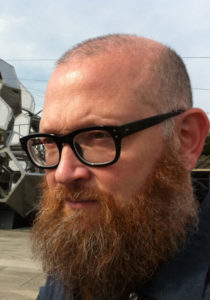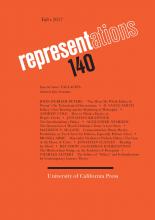How to Think a Figure; or, Hegel’s Circles
by Andrew Cole 
The essay begins:
No philosopher better epitomizes circular reasoning, nor more fittingly embodies the logical fallacy of circulus in probando, than G. W. F. Hegel, because he loves talking about circles and his points often go in circles. This essay isn’t about Hegel’s endearing oral delivery, about which plenty has been said since the man himself was alive. Rather, this is an attempt to think philosophically about circles and rethink so-called Hegelian circularity.
Why we would even bother thinking about circles is on account of their “eternal” symbolism within philosophy and theory—the fact that the circle always stands for something, ever the symbol of this or that thing you don’t really like. Invariably, that something is Hegel, on the grounds that he typifies the circularity of thought. For example, Ludwig Feuerbach writes: “The circle is the symbol and the coat of arms of speculative philosophy, of the thought that rests on itself. Hegel’s philosophy, too, as is well known, is a circle of circles.” This is indeed one of those long-standing clichés about Hegel. So it’s no surprise that Louis Althusser—whose anti-Hegelianism can be forgiven in the knowledge that he’s really not a deep reader of Hegel—draws a circle around himself in order to step out of it, striding from ideology to science:
The whole history of the “theory of knowledge” in Western philosophy from the famous “Cartesian circle” to the circle of the Hegelian or Husserlian teleology of Reason, shows us that this “problem of knowledge” is a closed space, i.e., a vicious circle (the vicious circle of the mirror relation of ideological recognition).
That’s a lot of circles, a lot of symbols. What do they mean? What do they really “show”?
These symbolic circles mean too much and not enough: call something a circle and the point about it is somehow immediately clear, but wait, how is something that’s not actually a circle like a circle or identical to a circle? Such symbolic circles mean what you want them to mean, which is exactly why all symbols are hopelessly bound up with the proverbial problem of meaning—tokens of the human need to line things up, to know where things go, ever since we first took soil for filth and polluted it accordingly. All the more reason, then, to think dialectically about our problem in an essay that both defends and extends Hegel’s thinking on this question of circularity and figures.
Our problem is this: Hegel rates figures below concepts but he needn’t always do so. In his mind, figures are just a bunch of numbers and lines annoyingly uncommitted to either Thought or Being. He also dislikes figures because they aren’t language, or are a lesser language. Hegel has his reasons for these positions. But those reasons may not be good enough, judging by the way he seems to equivocate about figures. Sometimes figures are so perfect as to figurate the very significance of his philosophy (and that’s no small feat!). And sometimes they are pretenders to proper conceptuality, conceptual thinking by other means. Hegel is all over the place on this question, as we’ll soon see. But if one applies even a modicum of mathematical wit to the figures Hegel does offer us—and most of them are circles, with triangles as a close runner-up—then we discover some rather interesting spaces in which dialectics might wander.
Here I propose that figuration (in my renewed Hegelian sense) is what Walter Benjamin tried to describe a century later as “dialectical images”—only Hegel’s figures are already in motion, are already an action, and already an “image of thought” that’s not static but dynamic. Figures are figures of thought because they move, just as thinking and the dialectic itself must move, according to Hegel. Figures both initiate and image the movement of thought. Figures are for thinking, whereas symbols are for reading and interpretation. Figures are dialectical. As such, they supply a way of practicing Hegel’s abiding ambition, as laid out in the preface to the Phenomenology of Spirit, “to bring fixed thoughts into a fluid state [festen Gedanken in Flüssigkeit zubringen],” so that we can apprehend “dialectical form [dialektische Form],” which is the representation of philosophical, critical thinking: in other words, Darstellung. Just what this thought process involves, the circle may help us grasp … and think. Continue reading …
In this essay Andrew Cole suggests that Hegel’s philosophy of the concept is also a philosophy of the figure, a demonstration of conceptuality by other means. Neither images nor symbols, Hegel’s figures—primarily, circles—initiate and image the movement of thought.
 ANDREW COLE is Director of the Gauss Seminars in Criticism and Professor of English at Princeton University. Forthcoming works include Foundations of the Dialectic and Unmodernism.
ANDREW COLE is Director of the Gauss Seminars in Criticism and Professor of English at Princeton University. Forthcoming works include Foundations of the Dialectic and Unmodernism.

 It is hard not to see that we are living in in an especially fallacious age; fallacies are evidently psychologically compelling. They appeal to our fear, anger, or pity; to our respect for authority; or to our faith in the power of numbers. A president will be blamed for an economic downturn that precedes him or credited for job growth that is inconsequent to his acts. As mistakes of logic, fallacies are not lies and not exactly nonsense either. Fallacies, in other words, are things that, not being valid, “are susceptible of being mistaken” for valid.
It is hard not to see that we are living in in an especially fallacious age; fallacies are evidently psychologically compelling. They appeal to our fear, anger, or pity; to our respect for authority; or to our faith in the power of numbers. A president will be blamed for an economic downturn that precedes him or credited for job growth that is inconsequent to his acts. As mistakes of logic, fallacies are not lies and not exactly nonsense either. Fallacies, in other words, are things that, not being valid, “are susceptible of being mistaken” for valid.